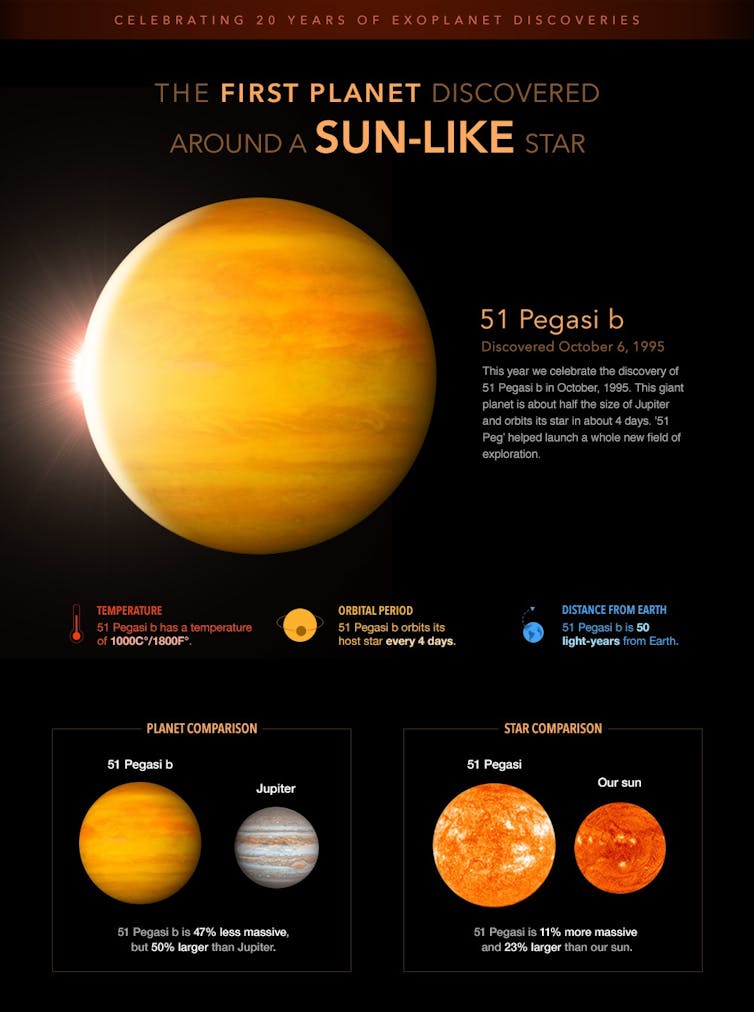The 2019 Nobel Prize in Physics was awarded for “contributions to our understanding of the evolution of the universe and Earth’s place in the cosmos.” Half the prize went to cosmologist Jim Peebles, and the other half was awarded jointly to Michel Mayor and my colleague Didier Queloz for the first discovery of an exoplanet orbiting a sun-like star. As someone who has spent a decade studying exoplanets, I know that this award marks a long-awaited recognition of one of the greatest revolutions in modern astronomy, one that has radically changed our perception of our place in the universe.
An exoplanet, or extrasolar planet, is a planet orbiting a star beyond our solar system. For thousands of years across many civilizations, humans have wondered whether worlds existed beyond the Earth and the solar system. It is humbling to realize that this question was only answered a mere 24 years ago.
In 1995, Mayor and Queloz discovered a giant exoplanet orbiting a sun-like star, 51 Pegasi. The planet, known as 51 Peg b, was similar in mass to Jupiter but 100 times closer to its host star, giving it a temperature of over 1,000℃. The discovery was radical in many ways, not least because it was altogether so different from the planets in our solar system and contradicted theories of planetary formation and evolution.
In our solar system, giant planets such as Jupiter and Saturn are five to ten times further from the sun than the Earth and have temperatures below -100℃. Jupiter and Saturn were thought to have formed in a gaseous disc around the infant sun by accumulating gas and ice, possibly even further away from the sun than they are now. The discovery of a “hot Jupiter” located so close to its star provided the first hint that planets could form in an extremely diverse array of other ways outside our solar system.
The discovery of 51 Peg b was a result of both technological prowess and serendipity. First, they had access to what was at the time one of the world’s most accurate instruments for measuring wavelengths of light from other stars, the ELODIE spectrograph at the Haute-Provence Observatory in southern France. But the time it takes to gather the evidence to prove the existence of an exoplanet depends on its mass, its distance from the star and how long it takes it to complete an orbit.

Existing theories and the model of our solar system meant that scientists didn’t expect to find any large planets with short orbits that could be found quickly. So no one was actively searching for them at the time. Mayor and Queloz were conducting what they thought would be a long-term program that could take years before finding a planet around another star. But, within about a year of starting observations, they discovered the first signs that the existing planetary theories were incomplete.
Their discovery came using a technique known as the radial velocity method. When a planet orbits around a star, the star also moves in a similar, but much smaller, orbit around the center of mass of the whole system. In other words, the planet’s gravitational tug on the star causes it to wobble around a point between them.
Because of this movement, the light from the star when seen from Earth changes, in what is known as a Doppler shift. When the star is moving towards an observer, its light has smaller wavelengths than when the star is stationary, making the light appear bluer. When the star is moving away from the observer, the light shifts to longer, redder wavelengths.
Detecting such wavelength shifts periodically indicates that another object, in this case a planet, is orbiting the star. And by measuring them over time, you can calculate the speed at which the star is moving towards or away from you (the radial velocity) and how long the planet’s orbit takes. The maximum radial velocity gives you a measure of the mass of the planet because larger planets located closer to the star cause the star to move faster.

In the early 1990s, the best spectrographs on Earth were capable of precisions of over 10 m/s, which meant that they were not capable of detecting planets as big, slow and far away from a star as Jupiter. But 51 Peg b was a Jupiter-size planet 100 times closer to its star, with an orbit of just 4.2 days rather than 12 years. This meant its maximum radial velocity was significantly higher at nearly 60 m/s, well within the range of Mayor and Queloz’s spectrograph.
After they had found the first signs of a planet with such a short orbit, the two scientists made further observations and detailed analyses that confirmed the properties of what we now know of as the hot Jupiter, 51 Peg b. Despite the intense scrutiny the results were subjected to, their findings were quickly confirmed by other teams using other instruments.
Mayor and Queloz’s revolutionary discovery of 51 Peg b sparked an avalanche of astronomical observations over the next two decades revealing the ubiquity and diversity of exoplanets that we know today. Over 4,000 exoplanets are now known, spanning the entire gamut of planetary properties, ranging from hot Jupiters to Earth-size planets in the habitable zones of their host stars. That means there are planets that are likely at the right temperatures for liquid water to exist on their surfaces, and for life as we know it to evolve.![]()
This article is republished from The Conversation by Nikku Madhusudhan, Reader in Astrophysics and Exoplanetary Science, University of Cambridge under a Creative Commons license. Read the original article.
Get the TNW newsletter
Get the most important tech news in your inbox each week.





